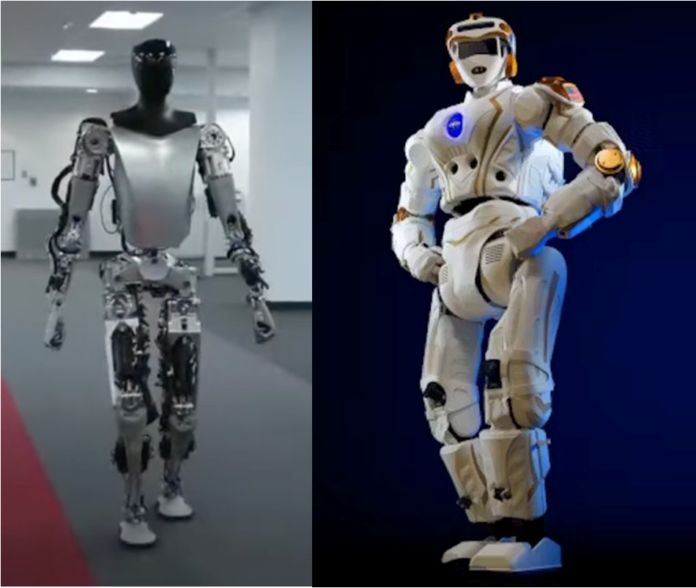Both Tesla and NASA have recently made news on the robot front. Tesla’s robot, called Optimus, at a recent showcase, was seen in videos walking, carrying items, and performing for investors. NASA’s Valkyrie, a successor to the legless robot assistant that first appeared on the International Space Station back in 2012 is headed to Western Australia to be put through its paces. So how do these two compare?
Optimus from Tesla
Elon Musk, CEO of Tesla, describes Optimus as the most advanced humanoid robot on the planet with built-in artificial intelligence. He states:
“I don’t think there’s anyone even close to Tesla on solving real-world AI. It’s not that helpful to have a humanoid robot if you have to program every action. It needs to be able to walk around autonomously and solve tasks. You should be able to instruct it in simple things, by showing visually what the robot needs to do, or just telling it what to do. That’s the key advantage that we have.”
Musk believes that future versions of Optimus will serve as home companions and also be used in industry. Optimus will one day help build Tesla automobiles.
Optimus navigates and moves using the same autopilot software that is in Tesla automobiles. Musk is so optimistic about Optimus that in his presentation to shareholders, he stated:
“My prediction is that the majority of Tesla’s long-term value will be Optimus. And I am very confident in that prediction.”
The company is stating that Optimus will become available within five years and Musk predicts that a ratio of robots to people will eventually exceed 1 to 1 in favour of the former.
Optimus specifications:
- powered by a 2.3 Kilowatt hour battery rated to operate throughout a normal day before needing to be recharged
- consumes 100 watts at rest and 500 watts when ambulatory
- weighs 72 kilograms (160 pounds)
- height is 173 centimetres (5 feet, 8 inches)
- top speed 9 kilometres (5 miles) per hour
- carrying capacity 20 kilograms (45 pounds)
- five fingers on each hand
- capable of autonomous operations and learns tasks by watching humans or another robot as an instructor
- projected unit cost is US $20,000
Valkyrie from NASA
Valkyrie is a humanoid robot designed to work as a remote mobile caretaker for use in space, on the Moon, and in the future on Mars. Designed by NASA’s Johnson Space Center and first revealed as Robonaut 2 to the public in 2010, it was legless when deployed to the ISS in 2012 where it performed menial tasks.
The current version of Valkyrie (Robonaut 5) specifications:
- powered by a 1.8 Kilowatt hour battery that allows it to operate for one hour before a recharge
- uses 2 Intel Core i7 processors to manage its operations
- weighs 136 kilograms (300 pounds)
- height is 188 centimetres (6 feet 2 inches)
- head equipped with a Carnegie Robotics Multisense SL vision sensor with fore and aft cameras
- arms have 4 elastic rotary actuators, 7-jointed forearms, and simplified 3-fingered hands
- outer surfaces are soft for humans to feel comfortable working with them nearby
- autonomous capability as well as the ability to operate it using telepresence or a remote control
- current unit cost is US $2 million
Until recently, Valkyrie has been plagued by poor performance largely because it has been over-engineered to try and serve multiple roles. The test in Australia will help iron out any existing deficiencies as NASA develops remote operating capabilities that will translate well to operating on the Moon, Mars, and uncrewed space stations and platforms.
Shaun Azimi, who leads the robotics team at the Johnson Space Center recently told The Robot Report that Valkyrie has new capabilities which will serve in the upcoming Artemis Program. He stated:
“We are pleased to be starting the next phase of development and testing of advanced robotic systems that have the potential to positively impact life on Earth by allowing safer operations in hazardous environments. These demonstrations will evaluate the current potential of advanced robots to extend the reach of humans and help humanity explore and work safely anywhere.”
Clearly, Valkyrie is not aimed at the same market as Optimus. It exhibits all the hallmarks of a NASA-engineered project. Hence the $2 million per unit price tag. Optimus, on the other hand, is being designed for mass production based on the same principles as its electric vehicle Tesla cousins.








